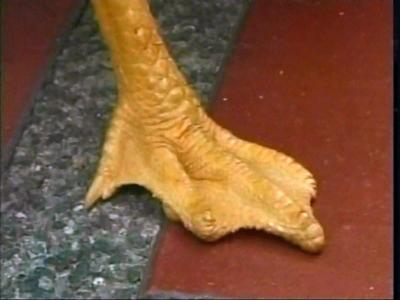 Not long ago in the country of Colombia, a chicken was born with webbed feet, similar to a duck (pictured).
Not long ago in the country of Colombia, a chicken was born with webbed feet, similar to a duck (pictured).
As some people suggested, this bird isn't the result of a duck sneaking into the hen house because experts say it's impossible for the two species to interbreed. Instead, experts said the bird is a genetic mutation.
 My guess is that the developmental genes that were supposed to cause programmed cell death for those cells located between the bird's toes did not activate and do their job properly. As a result, those cells survived, leaving the bird with skin remaining between its toes. This is a very basic developmental program that also leaves humans with fingers instead of webbed hands. I wonder what other genetic defects this bird might be harboring since programed cell death is basic to development.
My guess is that the developmental genes that were supposed to cause programmed cell death for those cells located between the bird's toes did not activate and do their job properly. As a result, those cells survived, leaving the bird with skin remaining between its toes. This is a very basic developmental program that also leaves humans with fingers instead of webbed hands. I wonder what other genetic defects this bird might be harboring since programed cell death is basic to development.
The bird's owner, who has raised chickens his entire life, said he's never seen the deformity before.
.
Cited story and image source.
tags: chicken with webbed feet


Your story with this is very interesting. What can be done to investigate what makes this ducken tick? Turning various genes on and off has interesting possibilities which I don't need to tell you.
Christopher
This is a simple variation in apoptotic triggering between the phalanges. It happens when the expression of retinoic acid fails to occur, thus not reducing the interdigital cell death. Similar things also occur in grebes, which form "lobes" between the digits. If you like, I have some cool images somewhere, stolen from a paper I found a while back.
I meant "thus reducing" not "thus not reducing". Damned low blood sugar!
Also, see these links
http://www.nature.com/ncb/journal/v1/n2/full/ncb0699_125.html
http://toxsci.oxfordjournals.org/cgi/content/full/90/1/208
Evolution before your very eyes. Truly a wondrous sight...humbling. In the right niche, this mutation, if passed on to this bird's offspring, would result in a new form of chicken...maybe a new species one day.
"What hath God wrought?"
Clapping
Chardyspal
I forgot to mention:
Why did the chicken cross the road?
Because it had webbed feet and was following the ducks.